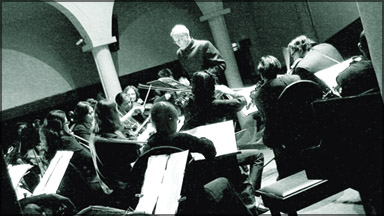The inaugural concert of the Chamber Music Society of Colombo
Enticing spell of classical music:
Reviewed by Indeewara Thilakarathne and Ranga
Chandrarathne
The most exciting and extremely relevant piece of serious avant garde
music of the inaugural concert of the Chamber Music Society of Colombo,
held recently at the Russian Cultural Centre, was the composition by
Stephen Allen on the legendary tusker Kandula.
Masahiko Shinohara was the soloist in Mozart's 14th piano concerto.
It was a feast to witness such technique. At times, he played as if in a
trance coupled with a remarkable digital agility. The concerto consisted
of three movements; Allegro vivace, Andantino and Allegro ma non Troppo.
The flesh and blood of this particular piece is the interesting
treatment Mozart gives to the overall structure. There is much interplay
between the piano and orchestra, subtle melodies being passed from one
section to another seamlessly. Chamber music of the very highest order.
It was a testament to the orchestra's finesse that it was able to do all
this with ease.
The CMSC interpretation of Mozart's Symphony No. 29, a work by the
teenage Mozart, completed on 6 April 1774 was engaging and dynamically
executed. It tested the orchestra's skills to the maximum, both
lyrically and technically. And once more, they were most convincing. One
of the impressive aspects of the concert was that it had no conductor,
except for The Dawn of Kandula, where the composer was invited to
conduct. Having a conductor may have been a distraction in the Mozart.
The members of the orchestra were so aware and sensitive to each
other's playing. And as aptly described by Lakshman Joseph de Saram,
this ensemble is like a finely calibrated racing yacht where all crew
members have an essential role to play.
The Chamber Music Society of Colombo attracts some of the finest
musicians in the country.
All in all, the concert was an eye-opener for the discerning
concertgoer. A challenging experience beyond being merely entertaining.
A new benchmark has been set. The Chamber Music Society of Colombo has
all it takes to become a jewel in the crown of Sri Lanka's living
cultural tradition.
--------------------------
 |
|
The
orchestra in concert |
The Dawn of Kandula, remarkable for its creative genius and fantastic
pageant of notes, re-created an episode (Mhv.xxv.5-83) as described in
the epic Mahavamsa. It certainly sounded like it was extremely difficult
to play, as it was not so immediately accessible to listen to, given the
subtle and complex grammar of music involved. However, the Chamber Music
Society of Colombo (CMSC) proved that it could perform this complex
music with aplomb and a certain flamboyance. Here, the Artistic
Director/Concert Master Lakshman Joseph de Saram should be commended for
his pioneering efforts to bring serious music within a Sri Lankan
context.
Sri Lankan concertgoers had the rare chance of witnessing the world
premiere of a remarkable piece of music which no doubt will make
history. Given the historical significance of the episode. The Dawn of
Kandula stands out as one of the best pieces of serious music based on a
historic fact of Sri Lanka. Allen deserves accolades for his
inspiration, indeed, a daunting task to translate a piece of prose into
absolute music given the inherent constraints of two entirely different
media. It was a moment of discovery. Here Stephen Allen captures the
subtle movements of the majestic tusker waking up at dawn and going for
a pensive stroll.
The dawn is portrayed by a bed of very soft strings playing what
seemed like one note, and on which two flutes mimic the sounds of
insects and early morning bird calls.
The composition can be loosely described as an elaborate orchestral
essay comprising of three distinct sections. The second section involves
the preparation for the final battle. The sound of a conch shell, played
on French horn, announces the forthcoming battle, which is then echoed
by trumpets building into a tremendous brass climax. The commencement of
the battle is signalled by the most vigorous scoring for strings, string
playing of such intensity that we actually felt the blood and guts of
battle.
The battle scene finally climaxes into the horrific sound of the
death cries of King Elara. A cry that is made by the entire orchestra
distorting on their instruments at the very highest levels of tonality.
After three massive orchestral chords, comes brief silence that serves
as an interregnum between the death of King Elara, and the dignified
procession to honour the noble king. This is vividly achieved by a faint
solitary hovering note on violin that gently morphs into the melodically
richly scored procession honouring the fallen king. The piece of
composition, a part of a set of compositions associated with Queen
Viharamahadevi, is the way in which composer Stephan Allen pays tribute
to a country and culture he is enchanted with. In a way, the composition
reflects the country's current political atmosphere. |

